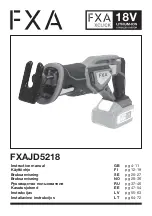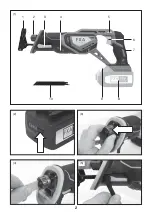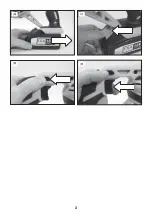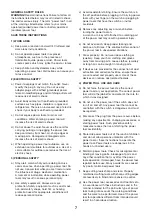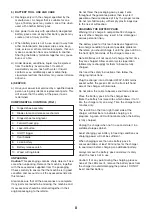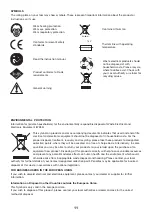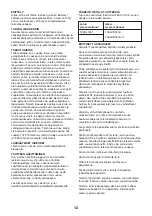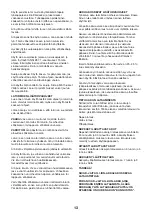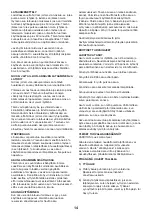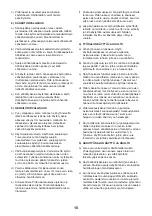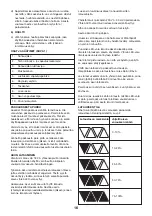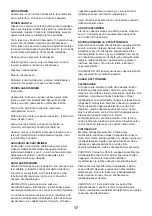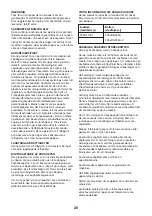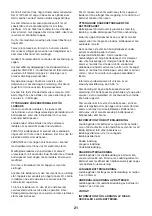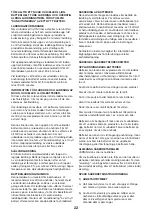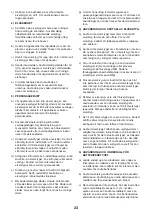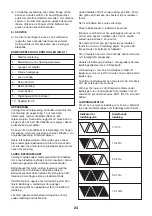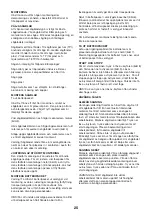
10
OPERATING THE SAW
GENERAL CUTTING
Hold the saw firmly in front of and clearly away from
you. Make sure saw blade is clear of any foreign
material. Be sure material to be cut is held firmly.
Small work pieces should be securely clamped in a
vice or with clamps to the work bench or table. Mark
the line of cut clearly. Depress the lock-off button,
then pull switch trigger to start the cutting action.
Place the base assembly against the work, then move
the blade into the work. Do not force. Use only
enough pressure to keep the saw cutting. Let the
blade and saw do the work. Use of excessive pressure
that causes bending or twisting of the blade may
result in broken blades.
PLUNGE CUTTING
Mark the line of cut clearly. Choose a convenient
starting point inside the area to be cut out and place
the tip of the blade over that point. Rest the front edge
of shoe assembly on the workpiece and hold firmly in
position. Depress the lock-off button, then pull the
On/Off trigger to start the cutting action.
WARNING: Make sure blade does not touch work until
motor reaches full speed, since this could cause loss
of control resulting in serious injury.
With saw blade at full cutting speed, slowly tilt saw
downward until tip of blade starts cutting work. After
blade penetrates work, tilt saw until blade is
perpendicular to the work.
WARNING:
blades longer than 15cm can whip and
should not be used for plunge cutting. Failure to heed
this warning can result in serious personal injury.
Cutting into electrical wiring can cause the blade, the
blade clamp, and the saw bar assembly to become
electrically live. Do not touch metal parts when cutting
into a wall; grasp only the insulated surfaces on the
tool. Make sure hidden electrical wiring, water pipes,
and mechanical hazards are not in the blade path
when cutting into a wall.
METAL CUTTING
You may cut metals such as sheet steel, pipe, steel
rods, aluminum, brass, and copper with the saw.
Observe the following tips when metal cutting:
Do not to twist or bend the saw blade.
Do not force the tool and use a slow speed setting.
Use cutting oil when cutting soft metals and steel.
Cutting oil also keeps the blades cool, increases
cutting action, and prolongs blade life.
Never use gasoline since normal sparking of motor
could ignite fumes.
Clamp the workpiece firmly and cut close to the
clamping point to eliminate any vibration of the
workpiece. When cutting conduit pipe or angle iron,
clamp the workpiece in a vice if possible and cut
close to the vice. To cut thin sheet material,
“sandwich” the material between hardboard or
plywood and clamp the layers to eliminate vibration
and material tearing.
Always keep firm pressure on the shoe to hold it
securely against the workpiece.
MAINTENANCE
WARNING! Always remove battery pack from your
tool when you are assembling parts, making
adjustments, cleaning, or when not in use. Removing
battery pack will prevent accidental starting that could
cause serious personal injury.
WARNING! When servicing only use identical
replacement parts. Use of any other parts may create
a hazard or cause product damage.
WARNING! Always wear safety goggles or safety
glasses with side shields during power tool operation
or when blowing dust. If operation is dusty, also wear
a dust mask.
GENERAL MAINTENANCE
Avoid using solvents when cleaning plastic parts.
Most plastics are susceptible to damage from various
types of commercial solvents and may be damaged
by their use. Use clean cloths to remove dirt, dust, oil,
grease, etc.
WARNING! Do not at any time let brake fluids,
gasoline, petroleum based products, penetrating oils,
etc., come in contact with plastic parts. Chemicals
can damage, weaken or destroy plastic which may
result in serious personal injury.
Tools used on fiberglass material, wallboard,
spackling compounds, or plaster are subject to
accelerated wear and possible premature failure
because the fiberglass chips and grindings are highly
abrasive to bearings, brushes, commutators, etc.
Consequently, we do not recommended using this
tool for extended work on these types of materials.
However, if you do work with any of these materials, it
is extremely important to clean the tool using
compressed air.
LUBRICATION
All of the bearings in this tool are lubricated with a
sufficient amount of high grade lubricant for the life of
the unit under normal operating conditions. Therefore,
no further lubrication is required.
TECHNICAL SPECIFICATION
Voltage
18V DC
No load speed
0-3000min
-1
Stroke length
25.4mm
Max cut in wood
80mm
Max cut in steel
10mm
Sound Pressure Level
L
pA
81 dB(A)
K=3dB(A)
Sound Power Level
L
WA
92 dB(A)
K=3dB(A)
Vibration Level
8.3 m/s
2
, K=1.5m/s
2
Содержание XCLICK FXAJD5218
Страница 2: ...2 1 7 1 5 3 2 9 8 6 10 4 5 3 2 4...
Страница 3: ...3 8 9 7 6...
Страница 37: ...37 2 FXA XCLICK FXADL1051 FXAJDB180Li FXAJDB180Li II...
Страница 38: ...38 ANSI Z87 1 10 25 35...
Страница 39: ...39 30 90 3 5 7 9 30 30 30 45 30 45 5 3...
Страница 40: ...40 1 2 3...
Страница 41: ...41 4 5 a b c d 6...
Страница 42: ...42 1 18 230 50 60 30 1 2 3 4 5 6 7 8 9 10...
Страница 43: ...43 2 10 14 18 3 4 5 6 0 10 10 25 25 50 50 75 75 100...
Страница 44: ...44 7 8 9 15...
Страница 45: ...45 18 0 3000 25 4 80 10 LpA 81 A K 3 A LWA 92 A K 3 A 8 3 2 K 1 5 2 WEEE...
Страница 46: ...46 130 Li ion...
Страница 73: ...73...
Страница 74: ...74...
Страница 75: ...75...

